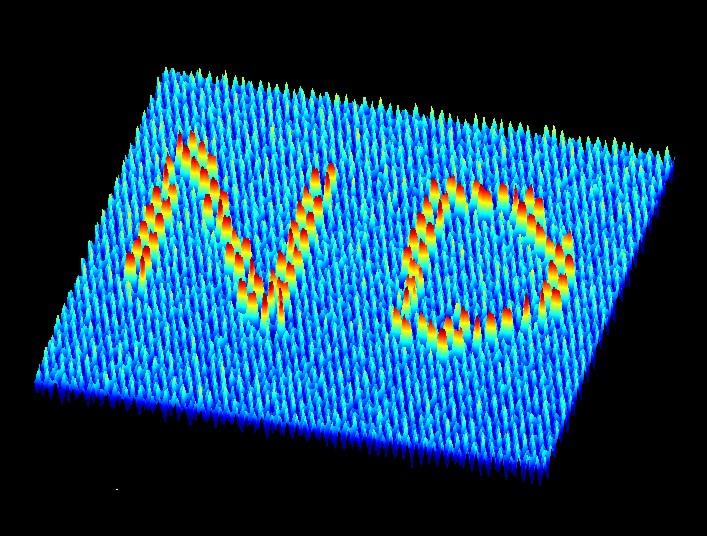Physicists create first metamaterial with rewritable magnetic ordering

These are magnetic force microscopy images of the patterned magnetic charge ice with 'ND' letters (initials of Notre Dame). Credit: Yong-Lei Wang/Zhili Xiao
Notre Dame physicist Yong-Lei Wang and his colleagues have found a new way of designing artificial spin ices with controllable magnetic ordered states. The new magnetic metamaterial forms eight types of 'magnetic charge' ordering and enables the first rewritable artificial magnetic charge ice (MCI) which follows the “two-positive two-negative” charge ice rule. The study demonstrates techniques to switch the charge ordering both globally and locally. The 'read-write-erase' multiple recording functionalities are conveniently realized at room temperature.
Artificial spin ice is a class of lithographically created arrays of interacting magnetic nano-islands. Due to its geometrical anisotropy, the elongated nano-scale island forms a single magnetic domain which behaves like 'macro spin' with a binary degree of freedom. The 'spins' in artificial spin ice follows the 'two-in two-out' ice rule that determines the proton positional ordering in water ice.
Scientists have created artificial spin ice systems as models to investigate complex magnetism in crystals and the related physics in a material that can be tailored with specialized properties and be investigated through direct imaging.
Due to the plethora of spin configurations, artificial spin ices have great potential for applications in data storage, memory, and logic devices. However, because of the large magnetic energy scales of these nanoscale islands at room temperature, achieving the magnetic ground and higher ordered states in traditional artificial spin ices have been a big challenge for nearly a decade since the first artificial spin ice was created. This essentially limits the practical application of artificial ices.
“We solved the challenge with a new way of thinking. Instead of focusing on spins, we tackled the associated magnetic charges that allow us to design and create artificial magnetic charge ices with more control,” said Wang, who designed the new magnetic nano-structures and built a custom magnetic force microscope (MFM) for the research. He is the first author and co-corresponding author on the study.
The stray magnetic field distribution of each elongated magnetic island can be represented as a dumbbell of magnetic charges, one positive and one negative. Wang and his colleagues demonstrated a very simple way to redesign the spin texture of artificial spin ice while maintaining its magnetic charge map. The decoupling of magnetic spins and magnetic charges enables them to create desired and new magnetic charge ordered states by tuning the magnetic textures through an applied external magnetic field.
“Our realization of tunable artificial magnetic charge ices is similar to the creation of a 'smart' material. It provides a versatile platform to advance our knowledge about artificial spin ices, to discover new physical phenomena and to achieve desired functionalities for applications,” said Zhili Xiao, who is the co-corresponding author on the study and holds a joint appointment between Argonne National Laboratory and Northern Illinois University.
The researchers also show how to use a magnetic tip of an MFM as a local perturbation of the applied field to flip 'single spin' and to manipulate local charge ordering. They demonstrated the 'read-write-erase' recording functionality of the magnetic charge ice at room temperature. They created micrometer scale magnetic charge letters 'ND' (the initial letters of Notre Dame) which is an excited magnetic state surrounded by a ground state background. This could lead to a new magnetic micro patterning technique by transferring these magnetic patterns to other materials through magnetolithography.
“By combining these magnetic nano-patterned structures with other materials such as superconductors, our rewritable magnetic charge ice provides an ideal and versatile playground to explore and control new emergent properties that can arise from novel hybrid structures,” said Wai-Kwong Kwok, who is the group leader of Argonne's superconducting and magnetism group and is a co-author of this study.
Media Contact
All latest news from the category: Physics and Astronomy
This area deals with the fundamental laws and building blocks of nature and how they interact, the properties and the behavior of matter, and research into space and time and their structures.
innovations-report provides in-depth reports and articles on subjects such as astrophysics, laser technologies, nuclear, quantum, particle and solid-state physics, nanotechnologies, planetary research and findings (Mars, Venus) and developments related to the Hubble Telescope.
Newest articles

A universal framework for spatial biology
SpatialData is a freely accessible tool to unify and integrate data from different omics technologies accounting for spatial information, which can provide holistic insights into health and disease. Biological processes…

How complex biological processes arise
A $20 million grant from the U.S. National Science Foundation (NSF) will support the establishment and operation of the National Synthesis Center for Emergence in the Molecular and Cellular Sciences (NCEMS) at…

Airborne single-photon lidar system achieves high-resolution 3D imaging
Compact, low-power system opens doors for photon-efficient drone and satellite-based environmental monitoring and mapping. Researchers have developed a compact and lightweight single-photon airborne lidar system that can acquire high-resolution 3D…





















